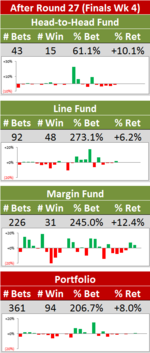When Is Kelly-Staking Superior to Level-Staking?
 Sunday, April 24, 2011 at 9:44PM
Sunday, April 24, 2011 at 9:44PM In the last blog we looked at a simple 5-parameter model of the contest between bookmaker and punter in which the bookmaker's and the punter's Home team probability assessments were assumed to be independently Normally distributed variables with possibly different means and standard deviations.
Two of the parameters were used for the punter, one to describe her bias towards or away from the Home team (relative to the true Home team probability) and the other to describe the variability of her probability assessments around the bias-adjusted mean. Two more parameters were used to describe the mean and the variability of the Home team probability assessments of the bookmaker, and the fifth was used to describe the bookmaker's overround, which is necessary to convert his probability assessments into head-to-head prices.
For this blog we're going to look at the conditions under which it's preferable to Kelly-stake rather than Level-stake. To answer this question I've undertaken a further series of simulations as follows:
- Select values for each of the 5 parameters subject to the following "reasonable" constraints:
- 0% <= Std Dev of Bookie Probability Assessment <= 5%
- -5% <= Bias in Bookie Probability Assessment <= +5%
- 0% <= Std Dev of Punter Probability Assessment <= 25%
- -5% <= Bias in Punter Probability Assessment <= +5%
- 100% <= Overround <= 110%
- For a given set of parameter values, simulate the Kelly-staking and Level-staking outcomes for 100 seasons each of 185 games
- Repeat for 1,000 different set of parameters
For each of the 1,000 parameter sets, either Kelly-staking or Level-staking will have produced superior aggregate returns across the 100 simulated seasons. With the binary variable indicating Kelly-Staking or Level-Staking superiority as the target variable and the parameter values as the regressors, we can fit a binary logit model to explore the relationship between the parameter values and the likelihood that Kelly-Staking is superior to Level-Staking.
More importantly, we can also perform hierarchical partitioning across all possible binary logit models to determine the relative contributions of the five parameters to explaining the superiority of Kelly-staking to Level-staking. When we do that it turns out that only two of the parameters make a substantial contribution:
- The Bookmaker's Bias, the independent contribution of which to explaining the variability in the superiority of Kelly-staking is just over 60%
- The Punter's Variability, the independent contribution of which to explaining the variability in the superiority of Kelly-staking is just over 30%
Combined, the Overround, the Bookmaker's Variability and the Punter's Bias contribute less than 10%, and the majority of that is contributed by the Overround.
That result is interesting in itself in that it tells us that - within the range of the parameters that we used for the simulations - the imprecision (variability) and greed (overround) of the bookmaker are relatively unimportant in helping us to decide whether to Kelly-stake or not, as is the bias in our own probability assessments. All that matters is the size and direction of the Bookmaker's Bias, if any, and the imprecision of our own probability assessments.
So now we know which parameters are important. One way to find out exactly how they're important is to employ a dose of rule induction. This gives us two rules which proscribe our staking preference for some combinations of Bookmaker Bias and Punter Variability:
- If the Bookmaker Bias is greater than +0.4% and the Punter Variability exceeds 9% then Level-Staking is generally superior (across all the parameter sets simulated, Kelly-Staking was superior for just over 41% of them; where these Bookmaker Bias and Punter Variability conditions were met it was superior in only just over 11% of them).
- If the Bookmaker Bias is less than +0.4% and the Punter Variability is under 9% then Kelly-Staking is generally superior (for simulations where the parameters met these conditions, Kelly-Staking was superior over 68% of the time).
It seems likely that most bookmakers for most games would have a Bookmaker Bias very near to zero, in which case Rule 2 above applies and the decision to Kelly-Stake or not comes down to whether we believe that the standard deviation of our probability assessments is greater or less than 9%. In other words, are we confident that we'll be within +/- 9% of the true probability about 70% of the time, and within +/- 18% of the true probability about 95% of the time?
If we are, then Kelly-Staking makes sense. If we're not, then it doesn't.
 TonyC |
TonyC |  Post a Comment |
Post a Comment | 

Reader Comments